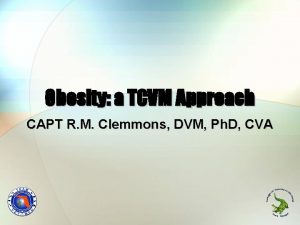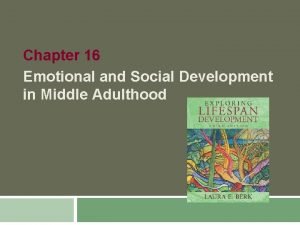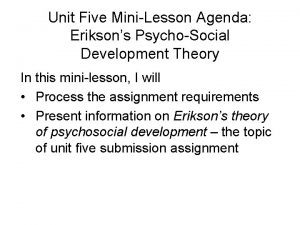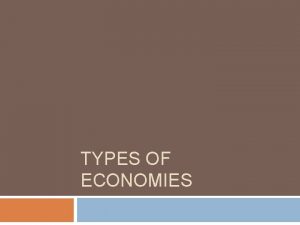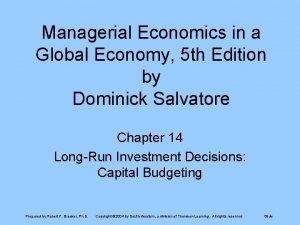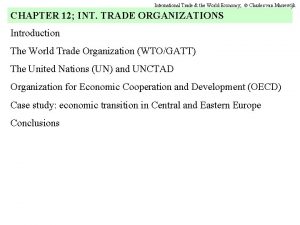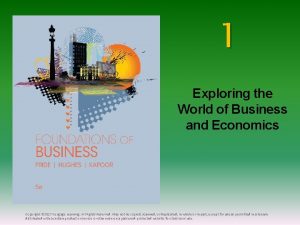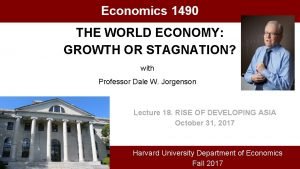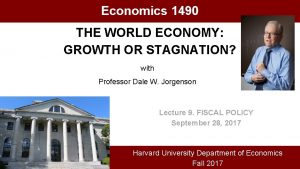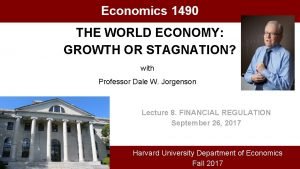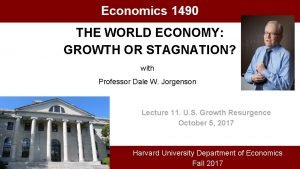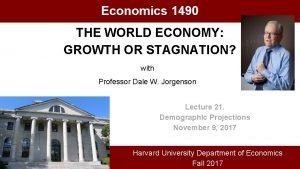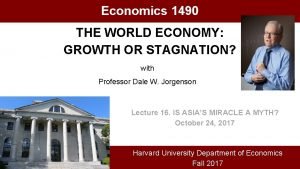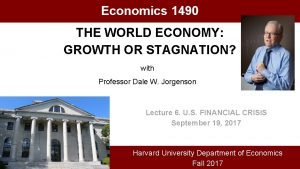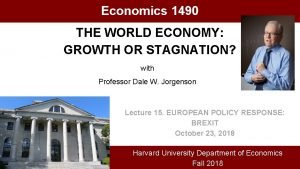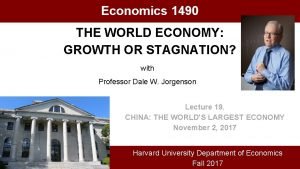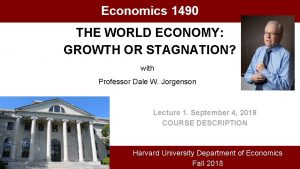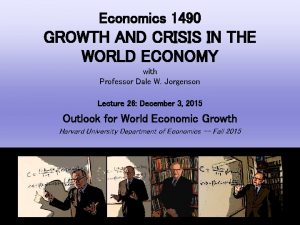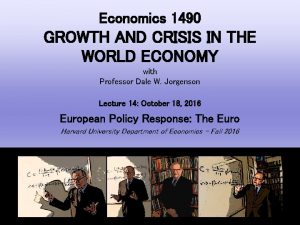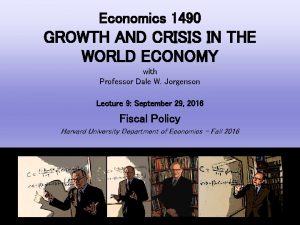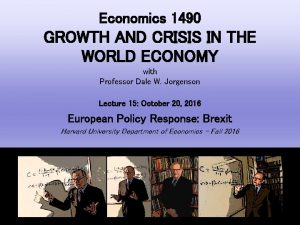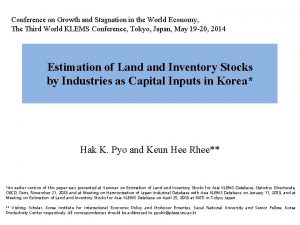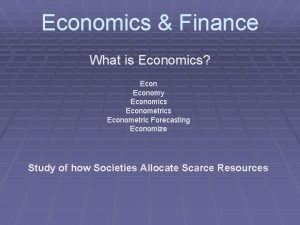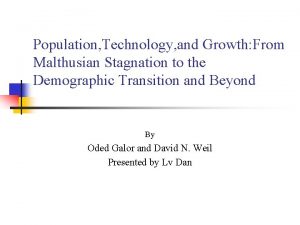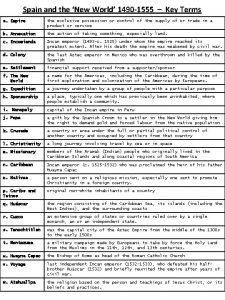Economics 1490 THE WORLD ECONOMY GROWTH OR STAGNATION
































- Slides: 32

Economics 1490 THE WORLD ECONOMY: GROWTH OR STAGNATION? with Professor Dale W. Jorgenson Lecture 26. World Economic Outlook November 30, 2017 Harvard University Department of Economics Fall 2017

THE WORLD ECONOMY: GROWTH OR STAGNATION? A. Comparing Economies B. U. S. Crisis and Recovery C. European Slowdown D. Asian Economic Miracles E. Sustainability of Economic Growth F. World Economic Outlook


MAJOR TRENDS IN THE WORLD ECONOMY • The Growth of the World Economy Has Accelerated Since 1995 and Become Much More Turbulent. • The Balance of the World Economy Is Shifting from the Advanced Economies of the G 7 to the Emerging Economies of Asia, Especially China and India. • The Transformation of the World Economy has Led to a New World Order, Led by China, the U. S. , India, and Japan.

THE SOURCES OF ECONOMIC GROWTH • Comparisons among Regions and Countries • Sources of Growth in Capital Input • Information Technology and Non-Information Technology • Labor Input and Labor Quality • Total Factor Productivity

MODEL OF PRODUCTION Production Possibility Frontier. where: I - Investment C – Consumption K – Capital L – Labor A - Total Factor Productivity (TFP)

SOURCES OF WORLD ECONOMIC GROWTH Average annual growth rates, weighted by the income share

SOURCES OF WORLD ECONOMIC GROWTH Average annual growth rates, weighted by the income share

SOURCES OF G 7 ECONOMIC GROWTH Average annual growth rates, weighted by the income share

SOURCES OF GROWTH FOR DEVELOPING AND TRANSITIONING ECONOMIES Average annual growth rates, weighted by the income share

PROJECTING THE GROWTH OF THE WORLD ECONOMY Future Demography: Population Projections for the World Economy Are Available from the United Nations. Labor Input Growth Includes the Growth of the Labor Force and Changes in Labor Quality Due to Age, Gender, and Educational Attainment. Future Productivity: Productivity Projections for the World Economy Are Available from The Conference Board in New York. These Are Based on Future Trends in the Development of Information Technology and Non. Information Technology. We Derive Output and Capital Input Projections from Future Trends in Demography and Productivity. Future Productivity Growth Is the Main Source of the Substantial Uncertainty in Projections of the Growth of the World Economy.

SOURCES OF AVERAGE LABOR PRODUCTIVITY GROWTH where: y = Y/H - Output per Hour Worked (ALP). k = K/H - Capital Input per Hour Worked. • CAPITAL DEEPENING: growth of capital input per hour worked, weighted by the share of capital. • LABOR QUALITY GROWTH: growth of labor input per hour worked, weighted by the share of labor. • TOTAL FACTOR PRODUCTIVITY.

RANGE OF WORLD OUTPUT PROJECTIONS

OUTLOOK FOR THE WORLD ECONOMY • The Growth of the World Economy Has Accelerated since 1990 and This Acceleration Will Continue for 2016 -2026. • Average Labor Productivity Growth for the World Economy in 2016 -2026 Will Slow Relative to 2006 -2016. • Growth of Hours Worked for the World Economy, 20162026, Will Be Very Similar to 2006 -2016. • Future World Economic Growth Will Be Subject to Substantial Uncertainty.

OUTLOOK FOR MAJOR REGIONS, 2016 -2026

OUTLOOK FOR MAJOR REGIONS Future Growth of the G 7: The Growth of the G 7 Economies Will Slow Modestly to 1. 02 Percent Per Year from Growth of 1. 14 Percent During the Past Decade 2006 -2016. This Slowdown Reflects the Failure of the G 7 Economies to Recover from the Great Recession that Began in the United States from 2007 -2009. The Upside Potential for Overcoming the Stagnation of the G 7 Economies Would Require a Revival in the Sources of Growth of Average Labor Productivity, Including Capital Deepening and Total Factor Productivity Growth. The Downside Potential for Continued Stagnation Would Involve a Further Decline in These Sources of Growth of Average Labor Productivity. Future Growth of Developing Asia: The Growth of Developing Asia Will Slow to 5. 33 Percent Per Year from Growth of 7. 11 Percent During the Past Decade 2006 -2016. The Economies of Developing Asia Will Continue to Grow More Rapidly Than the World Economy So That the Share of These Economies in World GDP Will Rise from 35. 86 Percent in 2016 to 44. 39 Percent in 2026. The Upside Potential for Developing Asia Is to Continue the Relatively Rapid Growth of the Past Decade. This Would Require a Continued High Rates of Capital Deepening and Rapid Total Factor Productivity Growth. The Downside Potential Is for Weaker Capital Deepening and Lower Growth of Total Factor Productivity.

OUTLOOK FOR THE G 7, 2016 -2026

OUTLOOK FOR THE G 7 Future U. S. Economic Growth: Our Projection Is for a Decline of the Slow Growth of 1. 49 Percent Annually for the Past Decade, 2006 -2016, to Potential Growth at 1. 34 Percent Annually for the Decade, 2016 -2026. Downside Risk for the U. S. Economy Is the Failure of Attempts to Develop a Sustainable Fiscal Policy. Upside Potential for the U. S. Economy Is a Substantial Stimulus to Growth from a Long Overdue Major Tax Reform. Future Japanese Growth: Our Projection Is for a More Substantial Slowdown from Growth Around 0. 74 Percent Annually for the Past Decade to Potential Growth of 0. 21 Percent for the Next Decade. Adverse Demographic Trends Pose Major Obstacles. The Major Downside Risk for the Japanese Economy is Continuation of the Stagnant Productivity Growth of the Past Two Decades. A New Growth Strategy Will Be Required to Overcome the Two Decades of Economic Stagnation.

OUTLOOK FOR EMERGING ECONOMIES, 2016 -2026

OUTLOOK FOR THE EMERGING ECONOMIES Future Chinese Economic Growth: Our Projection Is for a Substantial Slowdown from 9. 07 Percent Growth for the Past Decade, 2006 -2016, to a Sustainable Growth Rate of 5. 64 Percent for the Next Decade, 2016 -2026. This Is Well Below Official Chinese Projections. The Major Downside Risk for the Chinese Economy Is for Financial Distress Due to Unmanageable Levels of Debt. The Upside Potential of the Official Projections Would Require Major Financial and Fiscal Reforms Yet to Be Undertaken. Future Growth of the Indian Economy: Our Projection Is a More Modest Slowdown from the Growth of the Past Decade, Almost 7. 10 Percent Annually, to a More Sustainable 6. 62 Percent Annually in the Coming Decade. The Downside Risk for the Indian Economy Is Failure to Restore Fiscal Balance and Maintain Control of Inflation. The Upside Potential of India’s Favorable Demographic Trends Depends on Labor Market Reform and Greatly Increased Integration with the World Economy.

SUMMARY OF THE TRANSFORMATION OF THE WORLD ECONOMY Despite the Economic Turbulence of the Past Two Decades, the World Economy Is Entering a Period of Sustainable Growth at a Rate of almost 3. 2 Percent Annually, Only Slightly below the Growth Rate of 3. 3 Percent for the Past Quarter Century. Relative Importance of the Major Emerging Economies, China and India, Will Continue to Increase, Even with Much Slower Growth in China and a Modest Slowdown in India. Growth Potential Will Decrease in Both Japan and the U. S. Upside Potential Growth of the World Economy Is Considerable, But Would Require Ambitious Domestic Reforms in the Major Emerging Economies that Appear Unlikely. Downside Risks Are for Continued Stagnation of Productivity Growth around the World. Conclusion: The Base Case Projection of World Economy Is for Moderate but Sustained Growth and a Continuing Shift from the Advanced Economies of the G 7 to the Major Emerging Economies. This Has Established the New World Order of the 21 st Century.







OUTLOOK FOR THE WORLD ECONOMY, 2016 -2026

OUTLOOK FOR THE WORLD ECONOMY, 2016 -2026

MEDIUM TERM OUTLOOK FOR THE WORLD ECONOMY • According to the IMF the world economy will return to the high levels of growth of 2004 -2008. • This will close most of the gap between potential and actual growth. • Developing Asia, especially China and India, will grow very rapidly, shrinking the gap between levels of GDP for advanced and emerging economies. • The U. S. will continue to grow more rapidly than Europe and Japan.


THANKS FOR BEING SUCH A GREAT CLASS!
 Christopher columbus map of exploration
Christopher columbus map of exploration Landmarks in humanities 5th edition
Landmarks in humanities 5th edition The economy: economics for a changing world
The economy: economics for a changing world Answert the public
Answert the public Generativity vs stagnation
Generativity vs stagnation Blood stagnation treatment
Blood stagnation treatment Stream line equation
Stream line equation Industry vs inferiority example
Industry vs inferiority example Initiative vs guilt example
Initiative vs guilt example Generativity stage
Generativity stage Generativity vs stagnation
Generativity vs stagnation Trust vs mistrust maladaptation
Trust vs mistrust maladaptation Courbe de croissance fille 0-2 ans
Courbe de croissance fille 0-2 ans Athens and sparta were both
Athens and sparta were both Traditional economy definition economics
Traditional economy definition economics Traditional economy definition economics
Traditional economy definition economics What are the three basic questions of economics
What are the three basic questions of economics Economics mixed economy
Economics mixed economy Traditional economy definition economics
Traditional economy definition economics Managerial economics in a global economy
Managerial economics in a global economy School of business and economics maastricht
School of business and economics maastricht What is mathematical economics
What is mathematical economics Growth analysis definition
Growth analysis definition Shoot system
Shoot system Growthchain
Growthchain Primary growth and secondary growth in plants
Primary growth and secondary growth in plants Vascular ray
Vascular ray Geometric growth graph
Geometric growth graph Neoclassical growth theory vs. endogenous growth theory
Neoclassical growth theory vs. endogenous growth theory Organic growth vs inorganic growth
Organic growth vs inorganic growth Fascist corporatist economy ap world
Fascist corporatist economy ap world World-economy
World-economy Exploring the world of business and economics
Exploring the world of business and economics





